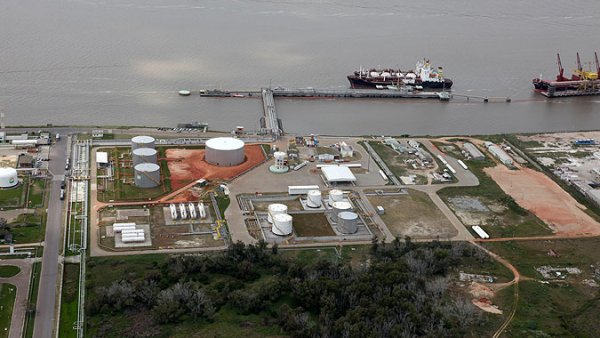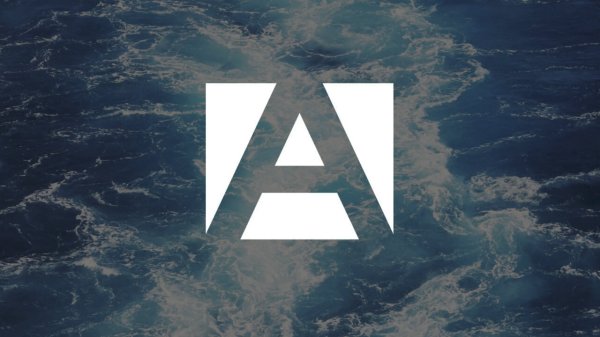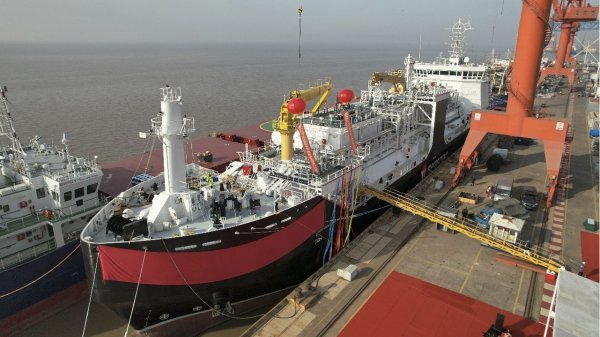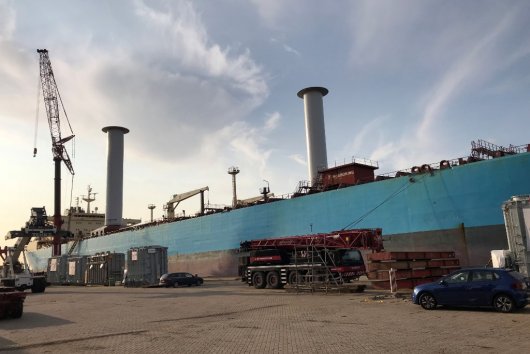Testing starts on first product tanker to use wind propulsion technology
Norsepower rotor sails installed aboard the Maersk Pelican.
Norsepower Oy Ltd., together with project partners Maersk Tankers, Energy Technologies Institute (ETI) and Shell Shipping & Maritime, have announced that testing has begun on the first product tanker vessel to use wind propulsion technology with the installation of two Norsepower rotor sails aboard the Maersk Pelican - a Maersk Tankers Long Range 2 (LR2) product tanker vessel.
The rotor sails are large, cylindrical mechanical sails which spin to create a pressure differential - called the Magnus effect - that propels the vessel forward. They are designed to provide auxiliary wind propulsion to the vessel and, as a result, optimize fuel efficiency by reducing fuel consumption. Associated emissions are said to be between 7 and 10 percent on typical global shipping routes.
The rotor sails are the world's largest at 30 metres tall by five metres in diameter and were installed on the product tanker vessel in the port of Rotterdam.
The rotor sails have already completed rigorous land testing - including thorough testing of various mechanical and performance criteria. They are the first to be class-approved for use on a product tanker vessel.
Following the installation, the first Maersk Pelican voyage with the rotor sails fitted is due to commence "shortly", according to the project partners.
Extensive measurement and evaluation of the effectiveness of the rotor sails is now set to take place to test the long-term financial and technical viability of the technology. Independent experts from Lloyd's Register's (LR's) Ship Performance team will acquire and analyse the performance data during the test phase to ensure an impartial assessment before technical and operational insights as well as performance studies are published.
As previously reported, the technology has already been used in a commercial environment, with two small units of Norsepower's rotor sails installed on board Bore's Estraden - a 9,700-deadweight-tonne (dwt) ro-ro carrier.
Also, in April, the Viking Grace became the world's first passenger ship to be equipped with Norsepower's rotor sail technology as well as the first LNG/wind electric propulsion hybrid ship.
Commenting on the initiative, Tommy Thomassen, Chief Technical Officer, Maersk Tankers, said: "This project is breaking ground in the product tanker industry. While the industry has gone through decades of technological development, the use of wind propulsion technology on board a product tanker vessel could take us to a new playing field. This new technology has the potential to help the industry be more cost-competitive as it moves cargoes around the world for customers and to reduce the environmental impact."
Andrew Scott, Programme Manager HDV marine and offshore renewable energy, ETI, explained: "We commissioned this project to provide a unique opportunity to demonstrate the untapped potential of Rotor Sails. Auxiliary wind propulsion is one of the few fuel-saving technologies that is expected to offer double-digit percentage improvements. The technology is projected to be particularly suitable for tankers and dry bulk carriers, and this test will assist in determining the further potential for Rotor Sails in the product tanker industry."
Tuomas Riski, CEO at Norsepower, observed: "We have great ambitions for our technology and its role in decarbonising the shipping industry. The installation of our largest ever rotor sails in partnership with these industry leading organisations shows that there is an appetite to apply new technologies.
"With this installation on the Maersk Pelican, there are now three vessels in daily commercial operation using Norsepower's rotor sails. Each of these cases represents a very different vessel type and operational profile, demonstrating the widespread opportunity to harness the wind through Flettner rotors across the maritime industry."
Dr. Grahaeme Henderson, Vice-President, Shell Shipping & Maritime, remarked: "The shipping industry faces a major challenge in how it can economically ship the increasing amounts of goods and energy the world demands, whilst lowering its environmental impact. We see significant advantages in embracing, testing and driving innovative technologies that we believe show real promise in helping the shipping industry meet this challenge."
The rotor sails are large, cylindrical mechanical sails which spin to create a pressure differential - called the Magnus effect - that propels the vessel forward. They are designed to provide auxiliary wind propulsion to the vessel and, as a result, optimize fuel efficiency by reducing fuel consumption. Associated emissions are said to be between 7 and 10 percent on typical global shipping routes.
The rotor sails are the world's largest at 30 metres tall by five metres in diameter and were installed on the product tanker vessel in the port of Rotterdam.
The rotor sails have already completed rigorous land testing - including thorough testing of various mechanical and performance criteria. They are the first to be class-approved for use on a product tanker vessel.
Following the installation, the first Maersk Pelican voyage with the rotor sails fitted is due to commence "shortly", according to the project partners.
Extensive measurement and evaluation of the effectiveness of the rotor sails is now set to take place to test the long-term financial and technical viability of the technology. Independent experts from Lloyd's Register's (LR's) Ship Performance team will acquire and analyse the performance data during the test phase to ensure an impartial assessment before technical and operational insights as well as performance studies are published.
As previously reported, the technology has already been used in a commercial environment, with two small units of Norsepower's rotor sails installed on board Bore's Estraden - a 9,700-deadweight-tonne (dwt) ro-ro carrier.
Also, in April, the Viking Grace became the world's first passenger ship to be equipped with Norsepower's rotor sail technology as well as the first LNG/wind electric propulsion hybrid ship.
Commenting on the initiative, Tommy Thomassen, Chief Technical Officer, Maersk Tankers, said: "This project is breaking ground in the product tanker industry. While the industry has gone through decades of technological development, the use of wind propulsion technology on board a product tanker vessel could take us to a new playing field. This new technology has the potential to help the industry be more cost-competitive as it moves cargoes around the world for customers and to reduce the environmental impact."
Andrew Scott, Programme Manager HDV marine and offshore renewable energy, ETI, explained: "We commissioned this project to provide a unique opportunity to demonstrate the untapped potential of Rotor Sails. Auxiliary wind propulsion is one of the few fuel-saving technologies that is expected to offer double-digit percentage improvements. The technology is projected to be particularly suitable for tankers and dry bulk carriers, and this test will assist in determining the further potential for Rotor Sails in the product tanker industry."
Tuomas Riski, CEO at Norsepower, observed: "We have great ambitions for our technology and its role in decarbonising the shipping industry. The installation of our largest ever rotor sails in partnership with these industry leading organisations shows that there is an appetite to apply new technologies.
"With this installation on the Maersk Pelican, there are now three vessels in daily commercial operation using Norsepower's rotor sails. Each of these cases represents a very different vessel type and operational profile, demonstrating the widespread opportunity to harness the wind through Flettner rotors across the maritime industry."
Dr. Grahaeme Henderson, Vice-President, Shell Shipping & Maritime, remarked: "The shipping industry faces a major challenge in how it can economically ship the increasing amounts of goods and energy the world demands, whilst lowering its environmental impact. We see significant advantages in embracing, testing and driving innovative technologies that we believe show real promise in helping the shipping industry meet this challenge."

|
IMO approves pricing mechanism based on GHG intensity thresholds
Charges to be levied on ships that do not meet yearly GHG fuel intensity reduction targets. |
|
|
|
||

|
VARO Energy expands renewable portfolio with Preem acquisition
All-cash transaction expected to complete in the latter half of 2025. |
|
|
|
||

|
NYK trials biofuel in milestone coal carrier test
Vessel is used to test biofuel for domestic utility company. |
|
|
|
||

|
H-Line Shipping orders LNG bunkering vessel
Vessel with 18,000-cbm capacity to run on both LNG and MDO. |
|
|
|
||

|
How to engineer and manage green shipping fuels | Stanley George, VPS
Effective management strategies and insights for evolving fuel use. |
|
|
|
||

|
Swedish government bans scrubber wastewater discharges
Discharges from open-loop scrubbers to be prohibited in Swedish waters from July 2025. |
|
|
|
||

|
MAN Energy Solutions achieves 100% load milestone for ammonia engine
Latest tests validate fuel injection system throughout the entire load curve. |
|
|
|
||

|
Petrobras secures ISCC EU RED certification for B24 biofuel blend at Rio Grande
Blend consisting of 24% FAME is said to have been rigorously tested to meet international standards. |
|
|
|
||

|
Stolt-Nielsen to fully control Avenir LNG with acquisition
Share purchase agreement to buy all shares from Golar LNG and Aequitas. |
|
|
|
||

|
Bureau Veritas supports launch of CIMC SOE's LNG bunkering vessel
Handover of Seaspan Energy's cutting-edge 7,600-cbm vessel completed. |
|
|
|
||
Related Links
- · Rotor sail firm Norsepower ready to back Paris GHG reduction targets [Insights]
- · Viking Line ferry set to save fuel with rotor sail retrofit [Insights]
- · Rotterdam [Directory]

